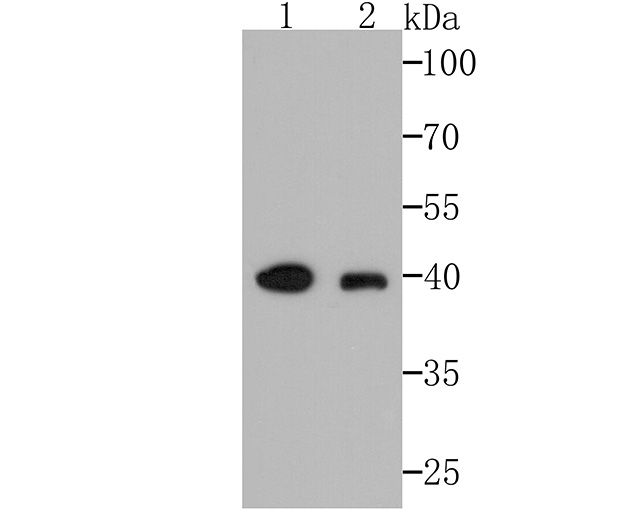AMACR Mouse Monoclonal Antibody [6F5]

cat.: EM1701-80
| Product Type: | Mouse monoclonal IgG1, primary antibodies |
|---|---|
| Species reactivity: | Human, Mouse, Rat |
| Applications: | WB |
| Clonality: | Monoclonal |
| Clone number: | 6F5 |
| Form: | Liquid |
| Storage condition: | Store at +4℃ after thawing. Aliquot store at -20℃. Avoid repeated freeze / thaw cycles. |
| Storage buffer: | 1*PBS (pH7.4), 0.2% BSA, 50% Glycerol. Preservative: 0.05% Sodium Azide. |
| Concentration: | 2ug/ul |
| Purification: | Protein G affinity purified. |
| Molecular weight: | Predicted band size: 42 kDa |
| Isotype: | IgG1 |
| Immunogen: | Recombinant protein within Human AMACR aa 1-382 / 382. |
| Positive control: | SiHa cell lysate, human liver tissue lysate, human kidney tissue, human liver tissue, human prostate carcinoma tissue, human colon carcinoma tissue, mouse kidney tissue, rat kidney tissue, A549. |
| Subcellular location: | Mitochondrion. Peroxisome. |
| Recommended Dilutions:
WB |
1:500-1:2,000 |
| Uniprot #: | SwissProt: Q9UHK6 Human | O09174 Mouse | P70473 Rat |
| Alternative names: | 2 arylpropionyl CoA epimerase 2 methylacyl CoA racemase 2-methylacyl-CoA racemase Alpha methylacyl CoA racemase Alpha methylacyl Coenzyme A racemase Alpha methylacyl-CoA racemase deficiency, included Alpha-methylacyl-CoA racemase Amacr AMACR deficiency, included AMACR_HUMAN CBAS4 Da1-8 EC 5.1.99.4 Macr1 Methylacyl CoA racemase alpha RACE RM |
Images

|
Fig1:
Western blot analysis of AMACR on different lysates. Proteins were transferred to a PVDF membrane and blocked with 5% BSA in PBS for 1 hour at room temperature. The primary antibody (EM1701-80, 1/500) was used in 5% BSA at room temperature for 2 hours. Goat Anti-Mouse IgG - HRP Secondary Antibody (HA1006) at 1:100,000 dilution was used for 1 hour at room temperature. Positive control: Lane 1: SiHa cell lysate Lane 2: Human liver tissue lysate |
Note: All products are “FOR RESEARCH USE ONLY AND ARE NOT INTENDED FOR DIAGNOSTIC OR THERAPEUTIC USE”.